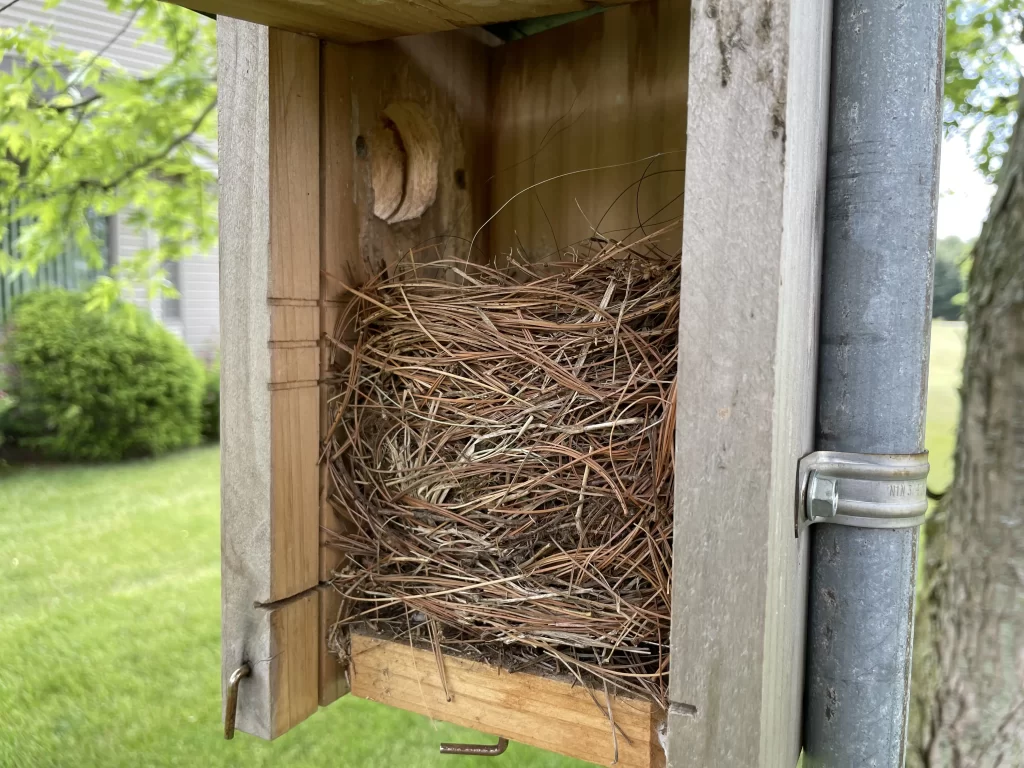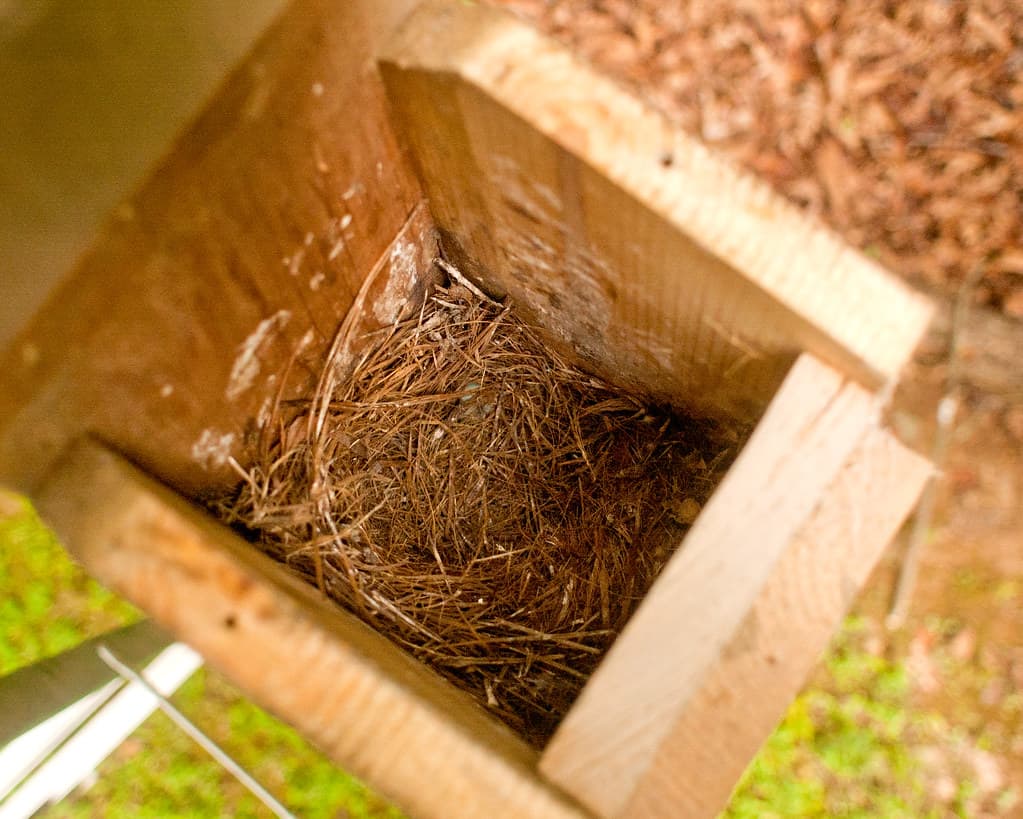
A 1994 study from the University of Kentucky found that bluebirds preferred to use nest boxes that contained old nesting material. Adult bluebirds would chose nest boxes with old nests more often than clean nest boxes (source). This might lead some people to believe that bluebirds reuse their nests. While the study might lead you to that conclusion, this is wrong.
As a general rule, bluebirds don’t reuse their nests. They either build a new nest in a different location, or build a new nest right on top of the old one. If you clean out an old bluebird nest from a nest box after the nestlings leave, bluebirds may return and build a new nest in the same box.
Even though Eastern Bluebirds in one particular study showed a preference for using nest boxes that contained old nesting material, that does not mean that they were actually reusing the old nest. Typical bluebird behavior shows us that there was probably more going on.
In this article we are going to talk about why bluebirds don’t really reuse their old nests, whether or not you should clean out your nest boxes after bluebirds leave, and what to expect for second and their bluebird nests.
Best Nest Box: My all-time favorite nest box for bluebirds is the Nature’s Way model CWH4. It has so many features that I love. Get one of these bird houses on Amazon here.
Why Bluebirds Don’t Typically Reuse Old Nests
The main reason that bluebirds don’t reuse their old nests is due to hygiene. After almost a month of use, a bluebird nest becomes filled with feces and urine from the baby birds. Nests can also become infested with pests (blowfly larvae being the most common).
Usability is also an issue with old nests. As baby bluebirds grow and leave the nest, the nest gets completely flattened. The weight of the bluebirds standing and climbing out of the nest pushes the nest down and compacts it.
Because of the hygiene and usability aspects of an old nest, a brand new nest is a necessary fresh start for each new brood of bluebirds. After the baby birds fledge, the female bluebird will soon begin building a new nest. She’ll either build the nest on top of the old flattened nest, or she’ll find a new location to build the second nest.
Recommended Reading: How Soon Do Bluebirds Start a Second Nest?
You can also remove the old nest and give the bluebirds a chance to rebuild in an empty box. There are a few advantages to doing this. Let’s discuss this next.

Removing vs. Not Removing Old Nests
Benefits of Removing Old Bluebird Nests
Once juvenile bluebirds leave the nest, I recommend removing the old nest and sweeping out the debris. This will create a more hygienic environment in the nest box that is less prone to attracting parasites. Even though bluebirds seem to show a slight preference for nest boxes containing old nesting material, the pros of a clean nest box outweigh the cons of attracting parasites.
In addition to the parasite issue, removing the old bluebird nest will also help keep the bluebirds safer from predators, such as cats and raccoons. Since bluebirds won’t have to build the new nest on top of an old one, predators won’t have as close of access to baby birds and eggs when they reach into the box. (With one nest built on top of another one, the nest can sometimes be too high and close to the entrance hole, causing baby bluebirds to become an easy target for predators).
For further reading, I wrote more about how and why to clean out old bluebird nests in this article here, called What to Do When Bluebirds Leave the Nest.
Benefits of NOT Removing Old Bluebird Nests
Although I recommend removing old bluebird nests after the fledglings leave the nest box, Eastern Bluebirds have been shown to prefer nest boxes containing old nests. This information comes from a 1994 University of Kentucky study.
If you want to leave a little bit of old nesting material in the nest box, go ahead and give it a try. You might see the same benefits that they saw in this study! I would encourage you to only leave a little bit of the nesting material in the nest box(not the whole nest), and to check to make sure the old nest doesn’t contain blowfly larvae.
What to Expect for a Second and Third Bluebird Nests
All three species of bluebirds can build up to 2-3 nests per year during the spring-summer nesting season. If you’re an avid bluebird enthusiast like me, you’re probably excited that you’ll have multiple opportunities to house bluebirds in your backyard nest box. So, when can you expect bluebirds to start building a second or third nest?
Typically, the female bluebird will start building a second or third nest about a week after the first brood of baby birds leaves the nest. This is especially likely to happen if the bluebirds had a good experience at the nesting site and if it’s still early in the summer. You can learn more about this topic in this article that I wrote here.
Conclusion
Even though a study suggests that bluebirds prefer to use nest boxes with old nesting material, this doesn’t actually mean that bluebirds reuse their old nests. Since old nests are often flattened and soiled with feces from the previous brood, bluebirds typically build a brand new nest for each new brood (either in a new location or on top of the old flattened nest).
Also, although some people might conclude that it is better to leave old nesting material in the nest box to attract bluebirds, I disagree. I recommend removing nesting material after bluebirds leave the nest in order to clean out the nest box. This will cut down on the chances of parasites infesting the nest and it will even help keep predators from reaching the baby bluebirds.
If you are interested in attracting bluebirds to your own back yard, read the article that I wrote for you here. It’s a great place to get started.

